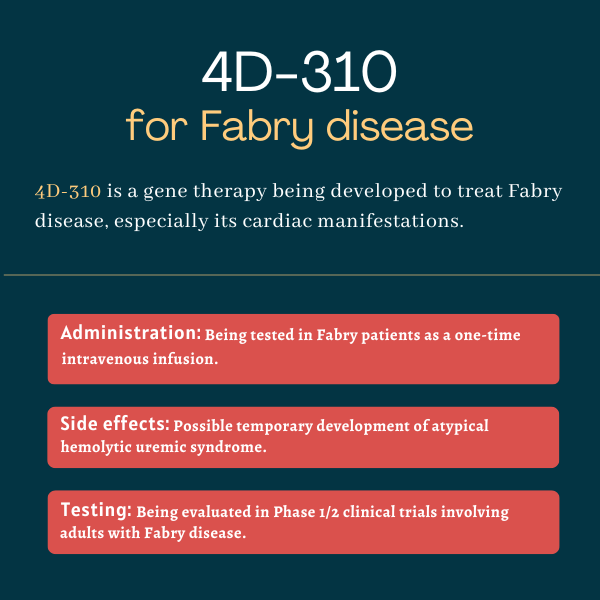
4D-310 for Fabry disease
Last updated Oct. 21, 2024, by Lindsey Shapiro, PhD

What is 4D-310 for Fabry disease?
4D-310 is an experimental gene therapy being developed by 4D Molecular Therapeutics as a possible treatment for Fabry disease. It’s given as a one-time intravenous, or into-the-vein, infusion.
Like other gene therapies, 4D-310 intends to address Fabry’s underlying genetic cause by providing patients with a healthy version of the GLA gene, but it is especially designed to have enhanced delivery to heart cells. It is thus expected to be better than existing Fabry disease therapies for controlling cardiomyopathy, a heart disease that is the leading cause of death for Fabry patients.
4D-310 has earned fast track designation from the U.S. Food and Drug Administration (FDA) for the treatment of Fabry disease. The status offers incentives to accelerate the development of therapies that could address an unmet need for the treatment of serious diseases.
Therapy snapshot
| Treatment name: | 4D-310 |
| Administration: | Being tested in Fabry disease as a one-time intravenous infusion |
| Clinical testing: | Currently being tested in Phase 1/2 clinical trials |
How does 4D-310 work?
Fabry disease is caused by mutations in the GLA gene which lead to a lack of alpha-galactosidase A (alpha-Gal A), an enzyme needed to break down certain fatty molecules, particularly globotriaosylceramide (Gb3), inside cells. Consequently, these molecules accumulate and cause organ damage. The heart is among the most commonly affected organs, with heart disease being a leading cause of death for Fabry patients.
A gene therapy, 4D-310 works to provide patients with a healthy version of the GLA gene. The goal is to deliver cells the genetic blueprint they need to produce their own alpha-Gal A enzyme in the long term, thereby lowering Gb3 levels and easing Fabry symptoms with a single intravenous infusion.
The gene therapy is packaged into a specialized viral carrier, or vector, called 4D-C102 that helps it be taken up by the body’s cells.
Compared with conventional viral vectors used for gene therapies, 4D-C102 is designed to achieve enhanced delivery to heart cells, and is thereby expected to have better efficacy for easing heart disease in Fabry patients. Still, the therapy is also able to reach other tissues affected in Fabry, such as the kidneys, liver, and blood vessel walls, allowing for alpha-Gal A production in multiple tissues.
How is 4D-310 administered?
In clinical trials, 4D-310 has been administered as a single intravenous infusion at a dose of 10 trillion vector genomes per kilogram of body weight (vg/kg). Clinical testing of the gene therapy is still ongoing, and additional doses are planned to be evaluated.
4D-310 in clinical trials
4D-310 is currently being evaluated in a pair of ongoing open-label Phase 1/2 trials — INGLAXA-1 (NCT04519749) and INGLAXA-2 (NCT05629559) — that are expected to cumulatively enroll 36 adults with Fabry disease and cardiac involvement. INGLAXA-1 is taking place in the U.S. and INGLAXA-2 in Taiwan and Australia.
All participants are receiving a single infusion of 4D-310, with the main goal of evaluating safety. Secondary goals include measures of cardiac function and life quality.
Interim data covering six treated patients with at least a year of follow-up showed that clinical measures of cardiac function were stable or improved for five evaluable patients a year after treatment. That was assessed by global longitudinal strain measurements, which essentially measure contraction of the heart’s muscle fibers.
Two patients with data out to two years continued to see clinically meaningful improvements.
Three of four evaluable patients also showed clinically meaningful improvements in exercise capacity, reflected by an increase in peak VO2, or the highest amount of oxygen consumed during exercise. Cardiomyopathy-related quality of life was also stable or improved, as assessed by the Kansas City Cardiomyopathy Questionnaire.
For one patient who underwent a cardiac biopsy, results showed that the gene therapy effectively reached the heart without causing inflammation, leading to increased alpha-Gal A levels and reduced Gb3 in heart cells.
Within around a week of receiving the gene therapy, three participants developed a temporary case of atypical hemolytic uremic syndrome (aHUS), a rare condition where the immune system becomes overactive, destroying red blood cells and causing blood clots to form in small blood vessels. This is a known possible effect of the viral vectors used in gene therapies, which can cause the immune system to react.
4D Molecular Therapeutics paused trial enrollment in early 2023, with the FDA placing a hold on INGLAXA-1 shortly thereafter. In October 2023, 4D Molecular Therapeutics aligned with the FDA on plans to lift the enrollment hold, including the launch of a study in nonhuman primates that would test the safety of an immunosuppressive treatment regimen containing rituximab and sirolimus to be given alongside 4D-310 as a way of lowering aHUS risk.

Common side effects of 4D-310
Clinical testing of 4D-310 in Fabry disease patients is still in its early stages, so its full side effect profile is not known. Early clinical trial data indicated that the treatment was not associated with cardiac or liver toxicities.
Some treated patients have temporarily developed aHUS, which can arise due to immune reactions against gene therapy vectors. A new immunosuppressive regimen is being developed to be administered alongside 4D-310 that is expected to prevent this side effect in future treated patients.
Fabry Disease News is strictly a news and information website about the disease. It does not provide medical advice, diagnosis or treatment. This content is not intended to be a substitute for professional medical advice, diagnosis, or treatment. Always seek the advice of your physician or other qualified health provider with any questions you may have regarding a medical condition. Never disregard professional medical advice or delay in seeking it because of something you have read on this website.
Recent Posts
- Canada approves ERT Elfabrio for adults with Fabry disease
- I work hard to influence my health outcome with Fabry disease
- Canadian study highlights stroke danger for young adults with Fabry
- Fabry treatment ST-920 boosts kidney, heart function in trial
- Echocardiograms may spot early heart disease in Fabry, study finds
- In rare case, woman diagnosed with both Fabry and blood disorder
- Companies challenge EMA advice rejecting monthly Elfabrio dosing
- ERT may protect heart function after Fabry kidney failure
- Helping my children with Fabry find ways to combat depression
- EU agency urges against monthly dosing plan for Fabry drug Elfabrio




